
8
ENGLISH
move the fence to allow clearance). Once the desired bevel angle has been set, tighten the bevel
clamp knobfirmly.
Bevel angles can be set up to 48° left and can be cut with the miter arm set between zero and 50°
right or left. At some extreme angles, the left side fence might have to be removed. To remove
the left fence, unscrew the fence locking knob
14
several turns and slide the fenceout.
Quality of cut
The smoothness of any cut depends on a number of variables. Things like material being cut,
blade type, blade sharpness and rate of cut all contribute to the quality of thecut.
When smoothest cuts are desired for molding and other precision work, a sharp (60 tooth
carbide) blade and a slower, even cutting rate will produce the desiredresults.
Ensure that material does not creep while cutting, clamp it securely in place. Always let the blade
come to a full stop before raisingarm.
If small fibers of wood still split out at the rear of the workpiece, stick a piece of masking tape on
the wood where the cut will be made. Saw through the tape and carefully remove tape
whenfinished.
For varied cutting applications, refer to the list of recommended saw blades for your saw and
select the one that best fits your needs. Refer to Saw Blades underAccessories.
Clamping the Workpiece (Fig. A)
WARNING: To reduce the risk of serious personal injury, turn off the tool and
disconnect it from the power source before attempting to move it, change
accessories or make anyadjustments.
WARNING: A workpiece that is clamped, balanced and secure before a cut may become
unbalanced after a cut is completed. An unbalanced load may tip the saw or anything the
saw is attached to, such as a table or workbench. When making a cut that may become
unbalanced, properly support the workpiece and ensure the saw is firmly bolted to a stable
surface. Personal injury mayoccur.
WARNING: The clamp foot must remain clamped above the base of the saw whenever the
clamp is used. Always clamp the workpiece to the base of the saw–not to any other part of
the work area. Ensure the clamp foot is not clamped on the edge of the base of thesaw.
CAUTION: Always use a work clamp to maintain control and reduce the risk of workpiece
damage and personalinjury.
If you cannot secure the workpiece on the table and against the fence by hand, (irregular shape,
etc.) or your hand would be less than 4" (100mm) from the blade, a clamp or other fixture must
beused.
For best results use the clamp
21
provided with your saw. Additional DW7090 clamps can be
purchased at your local retailer or DeWALT servicecenter.
Other aids such as spring clamps, bar clamps or C-clamps may be appropriate for certain sizes
and shapes of material. Use care in selecting and placing these clamps. Take time to make a dry
run before making the cut. The sliding fence
10
will slide from side to side to aid in clamping
To Install Clamp (Fig. A)
1. Insert the clamp
21
into one of the four locations
15
on thebase.
2. Lifting up on the arm of the clamp can rapidly adjust the height, then use the fine adjust
knob to firmly clamp theworkpiece.
NOTE: Place the clamp on the opposite side of the base when beveling. ALWAYS MAKE DRY
RUNS (UNPOWERED) BEFORE FINISH CUTS TO CHECK THE PATH OF THE BLADE. ENSURE THE
CLAMP DOES NOT INTERFERE WITH THE ACTION OF THE SAW ORGUARDS.
WARNING: A workpiece that is clamped, balanced and secure before a cut may become
unbalanced after a cut is completed. An unbalanced load may tip the saw or anything the
saw is attached to, such as a table or workbench. When making a cut that may become
unbalanced, properly support the workpiece and ensure the saw is firmly bolted to a
stablesurface.
WARNING: The clamp foot must remain clamped above the base of the saw whenever the
clamp is used. Always clamp the workpiece to the base of the saw–not to any other part of
the work area. Ensure the clamp foot is not clamped on the edge of the base of thesaw.
Support for Long Pieces
WARNING: To reduce the risk of serious personal injury, turn off the tool and
disconnect it from the power source before attempting to move it, change
accessories or make anyadjustments.
ALWAYS SUPPORT LONGPIECES.
Never use another person as a substitute for a table extension; as additional support for a
workpiece that is longer or wider than the basic miter saw table or to help feed, support or pull
theworkpiece.
For best results, use the DWX723, DWX724, DWX725B or DWX726 miter saw stand to extend the
table width of your saw. These are available from your dealer at extracost.
Support long workpieces using any convenient means such as sawhorses or similar devices to
keep the ends fromdropping.
Cutting Picture Frames, Shadow Boxes and Other Four-Sided
Projects (Fig. P)
To best understand how to make the items listed here, we suggest that you try a few simple
projects using scrap wood until you develop a “FEEL” for yoursaw.
Your saw is the perfect tool for mitering corners like the one shown in FigureP. Sketch A in
FigureP shows a joint made by using the bevel adjustment to bevel the edges of the two boards
at 45° each to produce a 90° miter corner. For this joint the miter arm was locked in the zero
position and the bevel adjustment was locked at 45°. The wood was positioned with the broad
flat side against the table and the narrow edge against the fence. The cut could also be made by
mitering right and left with the broad surface against thefence.
Cutting Trim Molding and Other Frames (Fig. P)
Sketch B in FigureP shows a joint made by setting the miter arm at 45° to miter the two boards
to form a 90° corner. To make this type of joint, set the bevel adjustment to zero and the miter
arm to 45°. Once again, position the wood with the broad flat side on the table and the narrow
edge against thefence.
The two sketches in FigureP are for four sided objectsonly.
As the number of sides changes, so do the miter and bevel angles. The chart below gives the
proper angles for a variety of shapes. The chart assumes that all sides are of equal length. For a
shape that is not shown in the chart, use the following formula. 180° divided by the number of
sides equals the miter or bevelangle.
EXAMPLES
No. Sides Angle Miter or Bevel
4 45°
5 36°
6 30°
7 25.7°
8 22.5°
9 20°
10 18°
Fig. P
A B
Cutting Compound Miters (Fig. Q, R)
A compound miter is a cut made using a miter angle and a bevel angle at the same time. This is
the type of cut used to make frames or boxes with slanting sides like the one shown in FigureQ.
NOTE: If the cutting angle varies from cut to cut, check that the bevel clamp knob and the miter
lock knob are securely tightened. These knobs must be tightened after making any changes in
bevel ormiter.
The chart (Table 1) will assist you in selecting the proper bevel and miter settings for common
compound miter cuts. To use the chart, select the desired angle “A” (FigureR, Angle A+Exteriors
Angles = 90°) of your project and locate that angle on the appropriate arc in the chart. From that
point follow the chart straight down to find the correct bevel angle and straight across to find the
correct miterangle.
Set your saw to the prescribed angles and make a few trial cuts. Practice fitting the cut pieces
together until you develop a feel for this procedure and feel comfortable withit.
EXAMPLE: To make a 4 sided box with 65° exterior angles(FigureR), 25°(Angle A)
= 90° – 65°(Exteriors
Angles), use the upper right arc. Find 25° on the arc scale. Follow the horizontal intersecting line to
either side to get miter angle setting on saw (23°). Likewise, follow the vertical intersecting line to
the top or bottom to get the bevel angle setting on the saw (40°). Always try cuts on a few scrap
pieces of wood to verify settings onsaw.
Fig. Q Fig. R
When Mitering to the Right
To increase the miter angle when mitering to the right, move the arm to align the appropriate
vernier mark with the closest mark on the miter scale to the right. To decrease the miter angle
when mitering to the right, move the arm to align the appropriate vernier mark with the closest
mark on the miter scale to theleft.
Exteriors
Angles
Angle A

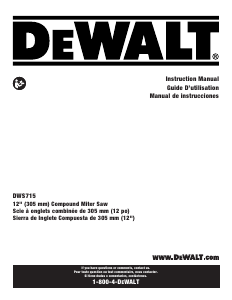


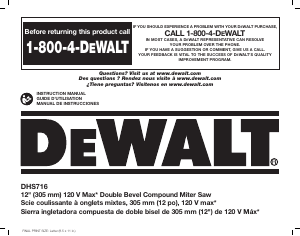

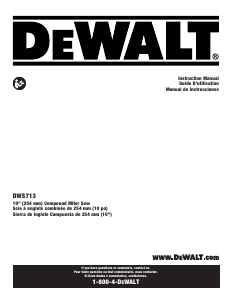


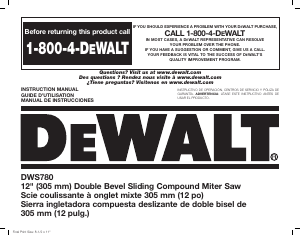
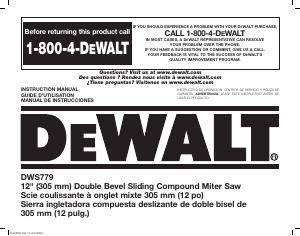
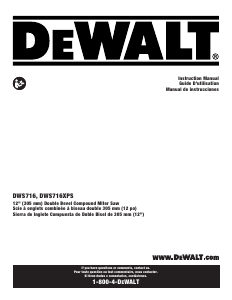
Join the conversation about this product
Here you can share what you think about the DeWalt DWS715 Mitre Saw. If you have a question, first carefully read the manual. Requesting a manual can be done by using our contact form.